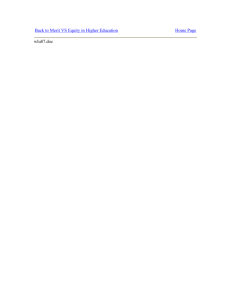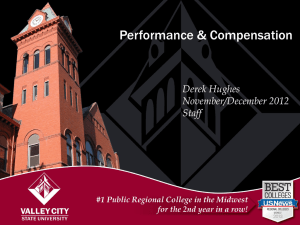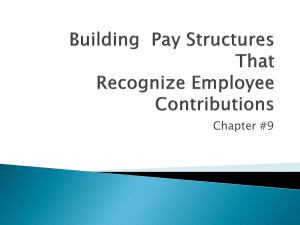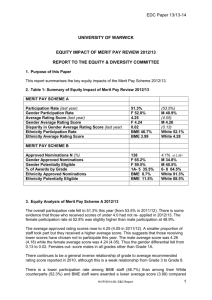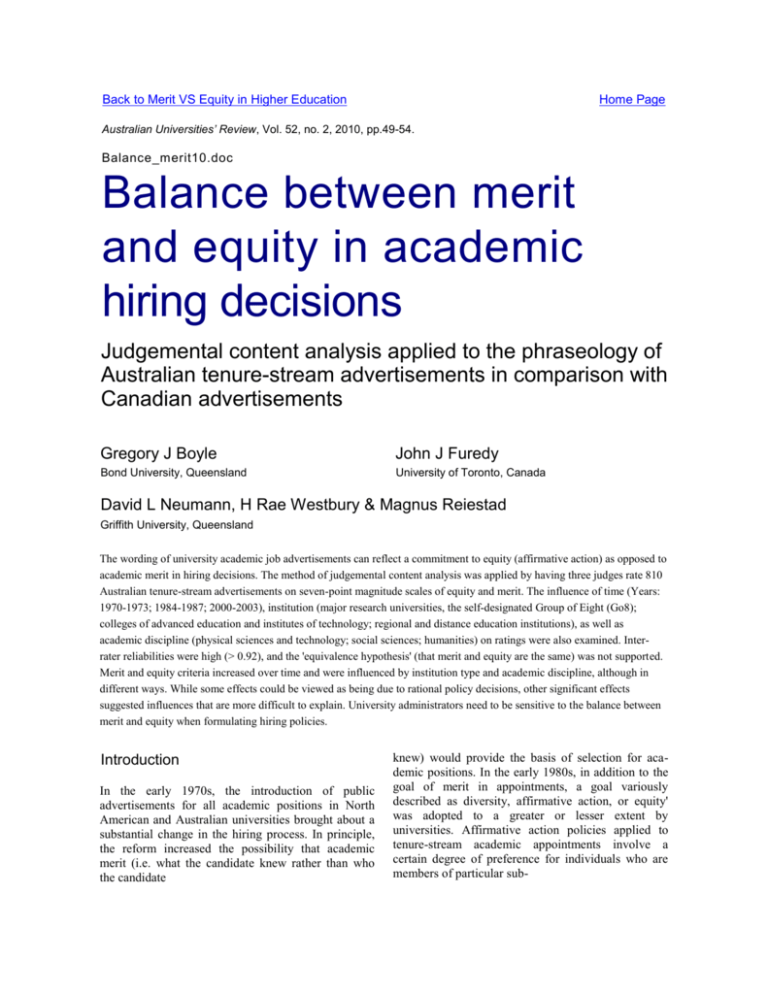
Back to Merit VS Equity in Higher Education
Home Page
Australian Universities’ Review, Vol. 52, no. 2, 2010, pp.49-54.
Balance_merit10.doc
Balance between merit
and equity in academic
hiring decisions
Judgemental content analysis applied to the phraseology of
Australian tenure-stream advertisements in comparison with
Canadian advertisements
Gregory J Boyle
John J Furedy
Bond University, Queensland
University of Toronto, Canada
David L Neumann, H Rae Westbury & Magnus Reiestad
Griffith University, Queensland
The wording of university academic job advertisements can reflect a commitment to equity (affirmative action) as opposed to
academic merit in hiring decisions. The method of judgemental content analysis was applied by having three judges rate 810
Australian tenure-stream advertisements on seven-point magnitude scales of equity and merit. The influence of time (Years:
1970-1973; 1984-1987; 2000-2003), institution (major research universities, the self-designated Group of Eight (Go8);
colleges of advanced education and institutes of technology; regional and distance education institutions), as well as
academic discipline (physical sciences and technology; social sciences; humanities) on ratings were also examined. Interrater reliabilities were high (> 0.92), and the 'equivalence hypothesis' (that merit and equity are the same) was not supported.
Merit and equity criteria increased over time and were influenced by institution type and academic discipline, although in
different ways. While some effects could be viewed as being due to rational policy decisions, other significant effects
suggested influences that are more difficult to explain. University administrators need to be sensitive to the balance between
merit and equity when formulating hiring policies.
Introduction
In the early 1970s, the introduction of public
advertisements for all academic positions in North
American and Australian universities brought about a
substantial change in the hiring process. In principle,
the reform increased the possibility that academic
merit (i.e. what the candidate knew rather than who
the candidate
knew) would provide the basis of selection for academic positions. In the early 1980s, in addition to the
goal of merit in appointments, a goal variously
described as diversity, affirmative action, or equity'
was adopted to a greater or lesser extent by
universities. Affirmative action policies applied to
tenure-stream academic appointments involve a
certain degree of preference for individuals who are
members of particular sub-
AUSTRALIAN
UNIVERSITIES’
groups (e.g. based on gender or ethnic background).
These policies were intended to produce equity' in
outcomes of the proportions of competition winners
from within the specified subgroups, rather than just
in opportunities to apply for such competitions.
Any preferential treatment given to certain applicants based on their subgroup membership can be
interpreted as being incompatible with a merit-based
system (Kranz 1974). The conflict between grouppreference and merit policies is especially problematic
when merit itself involves complex, expert
judgements, as is the case for academic tenure-stream
positions. The degree of commitment to employment
equity policy in tenure-stream hiring can vary
considerably along the equity-merit continuum. In
some universities, for example, equity officers' exert
direct pressure on departmental chairs regarding both
the wording of job advertisements and decisions on
appointments.
Institutional commitment to affirmative action is
partly influenced by conscious decisions made by university administrations. However, there may be less
conscious, latent influences that play a role in
determining the point of balance' universities settle on
regarding the somewhat conflicting principles of
equity and merit. It is possible to study systematically
the differential adaptations of universities (and even
within university sectors, such as the physical sciences
and technology versus the humanities). This approach
involves a content analysis of the phraseology of
tenure-stream advertisements to assess differences in
the relative degree of emphasis placed on merit and
equity respectively, as factors in hiring within
different institutions of higher learning.
Furedy et al. (2001) assessed the relative emphasis
of merit and equity in 519 advertisements for tenurestream positions at Canadian universities. They
reported that the inclusion of merit criteria increased
across the disciplines in order of the humanities, social
sciences, and physical sciences (which they labelled as
"hard sciences"), respectively. Merit requirements also
increased over time and according to the university
mission' of undergraduate, comprehensive, and
medical/doctoral, respectively. However, several
interactions also emerged to suggest that merit criteria
in advertisements were influenced differently
according to the combination of discipline, university
mission, and university location. As with the merit
findings, the inclusion of equity criteria in the
advertisements was influenced by university mission
in that it increased across the undergraduate,
comprehensive, and medical/doctoral institutions,
respectively, these being categories used to classify
uni-
50
REVIEW
versities in Canada. Also similarly, interactions
emerged between the various factors of time, location,
mission, and discipline. However, the number of
interactions seemed to be far more extensive for
equity than they were for merit. On the basis of these
findings, the authors suggested that many latent
influences exert their influence on merit and
particularly equity information in university tenurestream advertisements.
As shown in the study by Furedy et al. (2001), the
relationship between merit and equity can be
examined by considering the patterns of outcomes of
the merit and equity measures. On the one hand, the
various variables such as time and discipline may
influence merit and equity in the same way and
produce a similar pattern of results for each (the
equivalent hypothesis'). On the other hand, a different
pattern of results would indicate that the external
variables do not influence merit and equity in the
same way. In their analysis of Canadian tenure-stream
advertisements, Furedy et al. (2001) reported that the
pattern of results did differ between merit and equity,
and quite dramatically at times. The investigators
concluded that merit and equity can be influenced by
conscious and unconscious (latent) pressures in
different ways. Further, these influences can
ultimately influence the hiring decisions for academic
positions (see also discussion by Furedy & Furedy
2003).
The extent to which the findings of Furedy et al.
(2001) apply to tenure-stream advertisements at Australian universities is not known. The present study
thus aimed to examine patterns in the inclusion of
merit and equity criteria in Australian university
advertisements across different time periods,
disciplines, and types of institutions. The examination
of the results for merit and equity in isolation will
indicate the extent to which the inclusion of this
information is influenced by these factors. Moreover,
merit and equity criteria may be directly compared.
The equivalence hypothesis implies that, aside from
errors of measurement, merit and equity measures
should be strongly correlated. Moreover, the
equivalence hypothesis would lead to the prediction
that merit and equity will be influenced in the same
way by the variables of Time, Discipline, and
Institution and their interactions.
The method of judgemental content
analysis of tenure-stream
advertisements
Selection and categorisation
A total of 810 tenure-stream advertisements were
sourced from archives of the Wednesday and Saturday
Balance between merit and equity in academic hiring decisions, Gregory J Boyle et al
vol. 52, no. 2, 2010
AUSTRALIAN
UNIVERSITIES’
editions of The Australian newspaper. Only advertisements that were made during one of three time periods
were sourced. The first time period was 1970 to 1973,
when the use of open advertisements for all tenurestream positions was instituted. The second time
period of 1984 to 1987 is a pre-amalgamation period
because it spans the time just before the so-called
Dawkins reforms. After this time period, colleges of
advanced education and institutes of technology were
either amalgamated with universities (e.g. Melbourne
College of Advanced Education became part of the
University of Melbourne) or were elevated to full
university status (e.g. Queensland Institute of
Technology became the Queensland University of
Technology). The third time period was 2000 to 2003
and it can be considered to be a post-amalgamation
period in Australia. The three time periods thus span
the levels of open advertisements, pre-amalgamation,
and post-amalgamation.
The tenure-stream advertisements within each time
period were also classified according to discipline and
the academic status of the institution. The disciplines
were classified as physical sciences and technology,
the social sciences, or the humanities, respectively, in
terms of their quantitative scientific demands. The
institutional type was classified as Group of Eight
(Go8) universities, combined Institutes of Technology
and Colleges of Advanced Education (CAET), or
Regional and Distance Education tertiary institutions
(RDE), respectively. However, there were some slight
exceptions with the institution categorisation scheme.
For example, Monash (Go8) has both a regional
campus, formally a stand-alone CAE, and distance
education. The institution categorisation was
essentially one of academic status or institutional
prestige.
Ratings of equity and merit
The 810 tenure-stream advertisements were rated by
three independent judges according to the respective
levels of merit and equity criteria they contained. The
relative emphases on merit and equity in tenurestream advertisements cannot be assessed by means of
completely objective methods such as counting the
frequency of certain words. The content analysis that
has to be applied (see Furedy et al. 2001 for details)
must be more subjective or ‘judgemental’, and
essentially involves the psychophysical method of
magnitude estimation by informed observers. The
content analysis involved a degree of subjectivity and
reliance on rater judgements.
The methods of content analysis utilised by Ilic
(1999) were improved upon by (a) having three rather
vol. 52, no. 2, 2010
REVIEW
than one judge, (b) undertaking extensive discussions
of rating methods to ensure adequate reliability with
the ratings, (c) using a quasi-random order of ratings
with respect to the categories of time, discipline, and
institution to avoid sequence effects, and (d) removing
university and department names from the job
advertisements so that they would not bias the ratings
made. Ratings were made based on the identification
of markers' associated with equity and merit. Merit
markers included: requests for published reprints and
preprints; demonstrated research ability; graduate
level teaching experience; strong academic
background, and evidence of ability to develop a
viable, externally-funded research program. Markers
associated with high equity wording included:
candidates from specified subgroups being given
preference' or especially' being encouraged to apply.
The judges rated the wording of the advertisements
using separate seven-point scales to score the degree
to which the advertisements emphasised merit and
equity. Higher ratings indicate a higher endorsement
of merit or equity in the advertisement.
Training was used to enhance reliability of the
ratings. For the training, a further 90 tenure-stream
advertisements were sourced from archives of the
Wednesday and Saturday editions of The Australian
newspaper, ensuring that the date of the advertisement
did not overlap with those examined in this study. The
three raters independently made ratings of equity and
merit for each advertisement. Next, the ratings made
by each rater were compared. When discrepancies of
two or more points on the seven-point scale occurred,
the possible reasons for the differences were
discussed. As a result, the individual raters were able
to be more comparable in their interpretation of
relative strength of equity and merit markers on the
measurement scale.
Evaluation of the reliability of the ratings
The reliability between the raters was assessed by
examining the observed inter-rater reliability coefficients. The mean inter-rater reliability estimates of
0.96 and 0.93 for merit and equity ratings,
respectively, indicated a high reliability in the ratings
made. A further check was conducted by calculating
the correlation in ratings between each pair of raters.
The individual correlations for merit ratings between
raters were 0.89 (A with B), 0.92 (A with C) and 0.89
(B with C). Likewise, for equity ratings, correlations
were 0.92 (A with B), 0.86 (A with C) and 0.82 (B
with C). Although the method of judgemental content
analysis is not strictly objective, the use of trained
raters thus yielded high
Balance between merit and equity in academic hiring decisions, Gregory J Boyle et al
51
AUSTRALIAN
UNIVERSITIES’
REVIEW
inter-rater reliability estimates for both merit and
equity.
Results
Relationship between merit and equity
Before statistical analyses, the merit and equity ratings
were each averaged across all three raters due to the
established consistency among them. The relationship
between merit and equity ratings was initially examined
by looking at the correlation between the two measures.
For the entire set of ratings, there was a moderate,
though statistically significant positive association
between merit and equity (r = .35,p < .001). The
association reflected that higher merit ratings were
associated with higher equity ratings.
To compare merit and equity directly, the statistical
approach called a factorial analysis of variance
(ANOVA) was used. This approach included merit and
equity ratings as correlated-samples Measures factor in
the analysis (cf. Hair et al. 2006). The ANOVA also
included the between-samples variables of Time (19701973, 1984-1987, 2000-2003), Discipline (physical
sciences, social sciences, humanities), and Institution
(Go8, CAET and RDE). The ANOVA can examine the
effect that each variable has on its own (called the main
effects) as well the combination of variables (called the
interactions) in terms of their association with merit and
equity ratings. Main effects and interactions emerge if
the test statistic associated with them has a probability p
< .05.
The resulting ANOVA employed a2x3x3x3
(Measures x Time x Discipline x Institution) design.
The equivalence hypothesis leads to the prediction
that the Time, Discipline, and Institution factors will
influence merit and equity in the same way. Thus,
there should be no interaction between the Measures
factor and these other factors. However, the analysis
yielded a statistically significant Measures x Time x
Discipline x Institution interaction, (8,1566) = 3.37, p
= .001. A significant Measures x Time x Institution
interaction was also found, F (4,1566) = 3.56, p =
.007. Finally, the Measures factor interacted
significantly with Time, F (2,1566) = 33.13, p < .001,
Discipline, F (2,1566) = 6.22, p < .002, and
Institution, F (2,1566) = 4.57, p = .011. These latter
two-wav interactions are represented
52
in Figure 1 for which it can be seen that the pattern of
results across the levels of each variable show some
similarities, but also differences for merit and equity.
An example of one difference is that merit ratings
declined in order of Go8, CAET, and RDE
institutions. In contrast, equity ratings declined in
order of Go8, RDE, and CAET institutions.
The interactions involving the Measures factor show
that, contrary to the equivalence hypothesis, merit and
equity were influenced differently by the various variables of Time, Discipline, and Institution. The exact
way in which they differed can be determined by
comparing the pattern of results in how these variables
influence merit and equity in isolation. The
subsequent statistical analyses were conducted with
this aim. Separate ANOVAs were run on merit ratings
and equity ratings and each employed a 3 x 3 x 3
(Time x Discipline x Institution) between-samples
ANOVA design.
Merit
The merit ratings averaged across each of the levels
for the variables of Time, Discipline, and Institution
are shown in Figure 1. The statistical analyses showed
a main effect for Time, F (2 783) = 187.01, p < .001,
indicating that ratings varied across the three time
periods. To work out exactly which time periods
differed statistically, the t-test was used with a
Bonferroni adjustment applied to correct for possible
statistical error associated with multiple comparisons.
These analyses
Balance between merit and equity in academic hiring decisions, Gregory J Boyle et al
vol. 52, no. 2, 2010
AUSTRALIAN
UNIVERSITIES’
indicated that all years differed significantly from
each other, all ts > 4.17, p < .001. Thus, merit
information increased from the open advertisement
years (1970-1973), to the pre-amalgamation years
(1984-1987), and again to the post-amalgamation
years (2000-2003).
The disciplines also differed in merit ratings, as
shown by a main effect for Discipline, _F (2,783) =
10.02, p < .001. Figure 1 indicates that merit information in advertisements declined across the disciplines
in order of the physical sciences, social sciences, and
humanities. However, only the difference between the
ratings for the physical sciences and humanities was
statistically significant, t (538) = 3.59, p < .001.
The final main effect for merit ratings concerned the
academic status of the institution. The main effect was
vol. 52, no. 2, 2010
REVIEW
significant, F (2,783) = 5.62, p < .01. It was due to a
statistically significant higher merit rating for the Go8
universities than for the RDE universities, t (538) =
2.51, p = .012.
Although each of the variables of time, discipline,
and institution exerted an influence on merit ratings
on their own, they also interacted in their effects. This
was shown by aTime x Institution interaction, F
(4,783) = 3.14, p < .05, and a three-way Time x
Discipline x Institution interaction, F (8,783) = 4.17, p
< .001. The interpretation of three-way interactions
can be complex. It is eased by comparing the effects
of two variables when the third is kept constant. For
the present purposes, it makes sense to compare the
different levels of institution at each year for each
individual discipline. Figure 2 shows the merit ratings
grouped by discipline. As can be seen, the social
sciences and humanities disciplines showed a different
pattern to the physical sciences.
Further statistical analyses were conducted to
examine the three-way interaction. Separate 3x3
(Time x Institution) AN0VAs were run for each
discipline. As expected, aTime x Institution
interaction emerged for the physical sciences
discipline F = 8.43, p < .001, and not for the other
disciplines, all Fs < 1.51, p > 05. For the physical
sciences, merit ratings increased for all institutions
from 1970-1973 to 1984-1987, all ts > 2.89, p < .005.
From 1984-1987 to 2000-2003, merit ratings
increased for the Go8 universities, t (58) = 5.25, p <
.001,but not for the CAET and RDE institutions, both
ts < 1.31, p > .05. To summarise this pattern of
results, merit ratings increased across each time period
for all institutions in the social sciences and
humanities and for the Go8 institutions in the physical
sciences. However, there was no increase in merit
ratings from the pre-amalgamation years (1984-1987)
to the post-amalgamation years (2000-2003) for the
CAET and RDE institutions in the physical sciences
discipline.
Equity
The equity ratings for each individual variable of
Time, Discipline, and Institution are shown in the
lower portion of Figure 1. As can be seen, the values
for the equity ratings are lower than for the merit
ratings and they showed some similarities, but also
some differences in the patterns across each of the
variables. The analyses showed a main effect of Time,
_F (2,783) =
Balance between merit and equity in academic hiring decisions, Gregory J Boyle et al
53
AUSTRALIAN
UNIVERSITIES’
209.03, p < 001. Similar to the merit ratings, there
was a significant increase in equity ratings from
1970-1973 to 1984-1987, t (538) = 18.49, p < .001,
and again from 1984-1987 to 2000-2003, t (538) =
5.82, p < .001. Unlike the merit ratings, there was no
significant main effect of Discipline for equity
ratings. A main effect of Institution was found, F
(2,783) = 13-30, p < .001, and it indicated that equity
ratings differed among the three groups of
institutions. Equity ratings were lower for the CAET
institution than the Go8 and RDE institutions, both ts
> 3.07, p < .002. Equity ratings for the Go8 and RDE
institutions did not differ, t (538) = .91, p > .05.
An examination of the interactions among the
variables revealed that only the Time x Institution
interaction was statistically significant, F (4,783) =
12.64, p < .001.To facilitate comparisons with the
merit ratings, Figure 3 shows the ratings for time and
institution grouped by discipline type. However,
further analyses on the interaction were averaged
across the disciplines because, unlike the merit
ratings, there was no significant three-way
interaction. As can be seen in Figure 3, all institutions
increased in equity ratings from 1970-1973 to 19841987, all ts > 9.12, p < .001. From 1984-1987 to
2000-2003 the increase was significant for RDE, t
(178) = 6.90, p < .001,but did not reach statistical
significance for the Go8 or CAET institutions, both ts
> 2.17, p > .03.
REVIEW
larity between merit and equity in some of the find-
Discussion
Summary and interpretation of findings
Taken together, the results show that the nature of
merit and equity information in advertisements for
tenure-stream academic positions differed across
time, institution, and discipline. The present study
yielded a significant, albeit moderate correlation
between merit and equity ratings to indicate that
higher merit criteria in advertisements were
associated with more equity information. In contrast,
a previous Canadian study yielded a non-significant
correlation (Furedy et al. 2001). The present findings
highlight a difference between Australian and North
American advertisements suggesting that in Australia
the conflict between implementing merit and equity
principles has not been as marked as in the Canadian
context. The simi-
54
ings, such as the increase in ratings across the three
time periods for both, also supports this conclusion.
However, the equivalence hypothesis that merit and
equity are the same did not receive complete support
because there were several differences in the patterns
of results between the merit and equity ratings. For
this reason, the effects of time, institution, and discipline were examined separately for merit and equity.
As to the merit and equity results examined individually some results would appear to reflect predictable adaptations by the universities. Examples of such
results include an increase of merit requirements over
time (e.g. as the proportion of candidates having postdoctoral experience has increased), discipline (e.g.
with
Balance between merit and equity in academic hiring decisions, Gregory J Boyle et al
vol. 52, no. 2, 2010
AUSTRALIAN
UNIVERSITIES’
the physical sciences requiring more extensive academic and research qualifications than the humanities
in say post-doctoral experience), and institution (e.g.
in more prestigious institutions requiring higher
academic merit). In the case of equity, the effect of
time (increased equity emphasis over time) can be
readily justified. It would appear to reflect that
academic human resource administrators were
becoming more aware of the importance of
proactively emphasising equity in the merit/equity
balance, rather than just being content to eliminate
non-merit-based sources of bias, such as prejudice
against female academic applicants.
Interaction effects involving the three variables of
time, institution, and discipline with merit and equity
were observed. An example was the significant
interaction between time and institution. For equity,
the CAET and G08 institutions fell behind the RDE
institutions in their equity emphasis in the later years.
This suggests that equity policies in academic
appointments have been further developed in regional
institutions, whereas they have not substantially
increased for the G08 or CAET institutions. It would
be interesting to determine whether this has had any
differential impact in actual hiring decisions at the
different types of institutions in the later years. An
interaction between time and institution was also
observed for merit. However, it may be unlikely that
this interaction reflects the same influences to that of
equity. For merit, the interaction between time and
institution was limited to the physical sciences
discipline and was contrary to the pattern found with
equity. In the last time period, the CAET and RDE
institutions fell substantially behind the G08
institutions for merit criteria. Indeed, the merit ratings
appeared to decline somewhat for the CAET institutions in this time period.
The present research had some limitations that could
be addressed in future research. The three categories
of physical sciences, humanities, and social sciences
captured many of the disciplines at university, but
could be expanded in future research to include other
disciplines, such as the creative and performing arts.
The present study also used three raters and obtained a
high degree of consistency among them in the ratings
made. However, future research could include more
raters to provide an even better check on the reliability
and appropriateness of the ratings for equity and
merit. Finally, future research could apply the
methods used here to examine more recent advertisements so that, when combined with the present
findings, the examination of the balance between
REVIEW
merit and equity in tenure-stream advertisements can
be extended over a longer time frame.
Conclusion
It appears that in adapting to the conflicting requirements of balancing' merit and equity considerations,
Australian universities have so far been able to adopt
more rationally justifiable policies than those that
appear to be operational in Canadian universities.
Nevertheless, in terms of the practical implications of
the present findings, university human resource
administrators responsible for hiring policies in
relation to academic staff need to consider potentially
discriminative influences such as affirmative action
that influence the wording of tenure-stream
advertisements, over and above those influences that
do not discriminate in favour of candidates from
particular subgroups. Further research into university
hiring policies would seem warranted, especially in
regard to its impact on student performance and
academic outcomes.
Gregory Boyle is Professor of Psychology at Bond University,
Queensland, Australia.
John Furedy is Emeritus Professor of Psychology at University of Toronto, Canada.
David Neumann is Senior Lecturer in Psychology at Griffith
University, Queensland, Australia.
Rae Westbury and Magnus Reiestad are doctoral students at
Griffith University, Queensland, Australia.
Acknowledgement
This study was funded by a Canadian Dormer
Foundation research grant.
References
Furedy, JJ, Fidler, S, Morgenstem, Y & Tryhor, W 2001,
'Judgmental content analysis of Canadian tenure-stream
advertisements to assess latent influences on institutional
commitment to affirmative action', Technical Report #1 for the
Dormer Canadian Foundation. Available from:
<http://www.psych.utoronto.ca/~furedy/Papers/me/JUDGM6.doc>.
Furedy, JJ & Furedy, CP 2003, 'Tenure-stream advertisements
before and after the 1995 'Common Sense Revolution' in Ontario',
Society for Academic Freedom and Scholarship Newsletter, 33, pp.
4-9.
Hair, JF, Black, WC, Babin, BJ, Anderson, RE & Tatham, RL
2006, Multivariate data analysis (6th ed.), Upper Saddle River,
NJ, Pearson/Prentice-Hall.
Ilic, K1999, 'Merit and equity in Canadian tenure-stream position
advertisements: Effects of time, location, mission, and discipline
hardness', Unpublished undergraduate thesis, Department of
Psychology, University of Toronto.
Kranz, H 1974, 'Are merit and equity compatible?', Public
Administration Review, 34, pp. 434-440.
vol. 52, no. 2, 2010
Balance between merit and equity in academic hiring decisions, Gregory J Boyle et al
55

